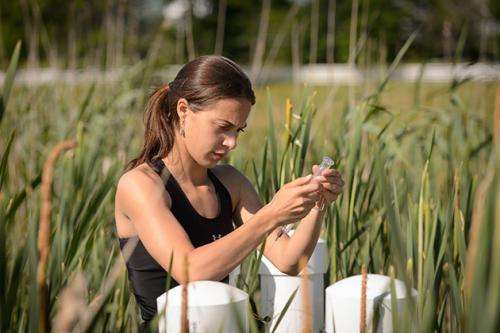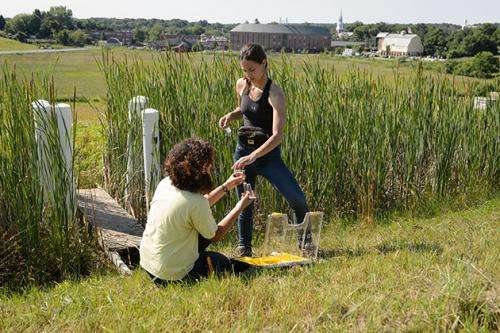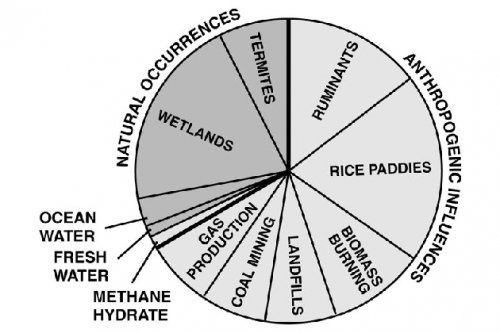Studying wetlands as a producer of greenhouse gases

(Phys.org) —Wetlands are well known for their beneficial role in the environment. But UConn Honors student Emily McInerney '15 (CAHNR) is studying a less widely known role of wetlands – as a major producer of greenhouse gases.
McInerney, a natural resources major with a concentration in climate and water resources, was awarded a UConn Summer Undergraduate Research Fund (SURF) grant to study the natural production of greenhouse gases by wetlands – in particular, the roles of water level and vascular plants in regulating the level of methane emissions from the wetlands.
Methane is a greenhouse gas that is less prevalent than carbon dioxide, but it traps radiation at more than 20 times the efficiency of carbon dioxide. And studies have shown that wetlands contribute between 15 percent and 45 percent of global methane emissions.
McInerney's research is based on the hypothesis that the levels of different greenhouse gases will fluctuate in relation to the water level in the wetlands. For example, she expects carbon dioxide, which requires oxygen in the microbial process to break down carbon and create the gas, to rise during dry conditions. And conversely, she expects methane emissions to rise during wet conditions, as the microbial processes that break down carbon to create methane do not require oxygen.
"By measuring the soil moisture and the corresponding gas levels, I expect to be able to determine the effect that water level has on the flux of gas emissions,"McInerney explains. "This is significant in light of the predicted effects of climate change on the seasonal precipitation patterns."

In a 2013 report, the National Oceanic and Atmospheric Administration projected that winter precipitation will increase by as much as 20 percent and summer precipitation will decrease by as much as 12 percent. McInerney expects these more frequent wetting/drying cycles to impact the natural fluxes in the production of methane gas.
The study is also measuring an additional variable – the effect of vascular plants (in this case, cattails) on the wetlands' gas emissions. Vascular plants contain tissues that transport water, nutrients, and gases throughout the plants and into the atmosphere. Vascular plants can also act as a conduit for the gases in the soil to be released into the atmosphere. McInerney is measuring whether the cattails have an effect on the amount of methane being released into the atmosphere.
According to Ashley Helton, assistant professor of natural resources & the environment and McInerney's faculty advisor on the research project, wetlands serve as a "huge sink" for collecting and filtering pollutants from the environment. "However, wetlands are also the largest natural source of methane, so we have an environmental tradeoff," Helton says. "The question is 'how could we optimize that balance between the benefits that the wetlands provide and the greenhouse gases that they emit?' Emily's research looks at what drives these fluxes in greenhouse gas emissions, and is an important step in understanding this tradeoff."
The study is being conducted in man-made wetlands on UConn's agricultural campus on Horsebarn Hill. The wetlands were originally constructed by UConn professor Jack Clausen in 1994 to study the effects of wetlands in treating the nearby Dairy Barn's milking parlor wastewater, but have not been used to treat wastewater for more than 10 years.

In order to capture the gases emitted from the wetlands, McInerney constructed gas sampling chambers from PVC pipe, along with 18 PVC "collars" mounted in the wetland's soil. Half of the collars contain cattails, while the other half are placed over soil without vegetation. Every week, she mounts the chambers on the collars and takes samples of gases from the sampling chambers at four-hour intervals, along with soil samples to measure the moisture of the soil.
The samples are then analyzed in Helton's lab in the Center for Environmental Science and Engineering, using gas chromatography to measure the fluxes in greenhouse gases. Over the course of eight weeks this summer, McInerney will have taken nearly 1,300 gas samples for analysis. She plans to complete her Honors thesis by the end of December.
For McInerney, who is also the incoming President of the EcoHusky student group, the research project has been well worth the 12-hour days of field sampling. "This project has been a great experience so far – from the application process that led to being awarded the SURF Grant, to the hands-on experience that I've been gaining in Dr. Helton's lab," she says. "I've gained a huge amount of practical experience in environmental science."
Provided by University of Connecticut















